EHP or Enterocytozoon Hepatopenaei is an yeast-like fungus belonging to a group called “microsporidia”, which are obligate intracellular parasites. It was first reported as an unnamed microsporidian from growth retarded black tiger shrimp Penaeus monodon from Thailand in 2004. This fungus infects the hepatopancreas of the shrimps, so it’s called as Hepatopancreatic microsporidiosis (HPM). It also has smaller spores (approximately 1 μm in length) and is currently known to infect both P. monodon and P. vannamei.
CAUSES
- Hepatopancreatic microsporidiosis (HPM) is an infectious shrimp disease caused by enteric fungi, Enterocytozoon hepatopenaei (EHP).
- EHP can be transmitted directly from shrimp to shrimp by cannibalism and cohabitation.
- Shrimps become infected by ingesting spores from the water, from sediment, from eating EHP-infected live feeds (polychaetes, molluscs, frozen artemia biomass etc).
SYMPTOMS
- The target organ of EHP is hepatopancreas and affects its digestive and absorptive functioning resulting in poor growth and immunity.
- EHP infected shrimp may have a thin cuticle, white muscle as a stress response, black spots on their eyestalks, in their muscle tissue and along the hind gut.
- It is associated with severe growth retardation in P.vannamei exhibits high size variability.
- Causes chronic mortality in severe cases.
- Associated with White Fecal Disease.
DIAGNOSTIC MEASURES
- Infection can be checked by microscopic examination ( at x100 oil immersion) of the hp and the gut of the shrimp.
- Infection can also be confirmed by molecular testing of the hp by PCR.
PREVENTION
Regular health assessments are recommended. If there is a large difference in the size of PL, if PL feeding activity is less than expected, the number of lipids in the hp drops, growth and moulting slows, then these are also good indications of infection. The number of swollen tubules may provide an indication of how advanced infections are.
Some important insights on practical solutions for managing EHP is described below:
HATCHERY
- The best approach for maturation and hatchery facilities to avoid EHP is to never use live animals (e.g., live polychaetes, clams, oysters, etc.) as feeds for broodstock. Use only SPF live polychaetes, SPF squid and other fresh feeds like Mussel (subjected to -20 degrees freezing for more than 48hrs) in maturation systems.
- Feed breeders with Redi-Mate in maturation system, a biosecure diet that could replace up to 50% of live polychaetes in commercial trials & 60% fresh feeds (without live polychaetes).
- Adopt ultrafiltration system in the hatchery system with 0.1micron size or lower to exclude spores.
- Recommended to remodel maturation system by expanding maturation system using imported PPL and accept lower spawn size without the use of live feeds.
NURSERY
- Stressors can provoke infection of EHP in ponds. Nursed PL can make animals robust and grow faster due to compensatory growth.
- Nursery cuts down culture period and reduce animals exposure to pathogens & stressors
- Adopt water filtration system in shrimp nurseries that could exclude spores.
- Use PL Raceway 40-9, a high quality nursery feeds proven to achieve FCR 0.8 at density 1-12pcs/Liter
GROWOUT
- The spores of EHP have thick walls and are not easy to inactivate. Even high levels of chlorine alone are not effective. Infected ponds should be treated with hot limes. Burnt lime CaMgO and Hydrated (Ca(OH)2) can increase pH and knock down spores at 6mt/ha. Need to moisten the pond prior to application. It needs water to react and activate to increase pH to 14.
- Stock EHP PCR-negative post larvae
- Treat all incoming water with 40ppm of 65% active chlorine or 15ppm KMnO4
- Ponds with sandy loam soil and high sedimentation should be PE lined. High suspended solids makes shrimps susceptible to EHP spores through oral ingestion.
- Manage water quality with the use of effective probiotics. Shrimps infected with EHP and challenge with Vibrio (mixed infection) after exhibit white feces.
























